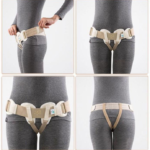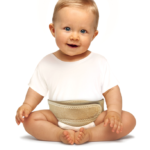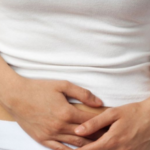How to choose a bandage for umbilical hernia
An umbilical hernia is a predominantly childhood disease that occurs during fetal development or after the birth of a baby. Pathology is treated with the use of a special corset, folk and medicines. In adults, this disease will be the result of high intraperitoneal pressure and muscle weakness, resulting in excess weight, coughing, constipation, bloating, and the period of gestation.
Treatment in children and adults includes the use of a device such as an umbilical hernia bandage.
A special belt is fixed at the waist, and a rigid insert keeps the navel in place. The bandage on the abdominal wall is also used after removal of the umbilical hernia. All corsets are universal, but there are also separate women's belts for wearing during pregnancy. Such a device prevents hernial bulging when there is a predisposition to this, and prevents its complication already in the presence of an ailment.
It is not difficult to choose such a belt, but it is important to understand that it is selected together with the attending physician and in no case is it replaced by a hand-made product.
The use of a belt for a hernia
A bandage for umbilical hernia is prescribed to hold the protrusion during muscle tension and when straining. Such a belt is not a remedy, but it is great for preventing complications before and after surgical removal of the hernial sac. The device is more often prescribed for young children, in whom the hernia can pass on its own.
In adults, protrusions in the abdomen in 99% of cases are eliminated only by hernioplasty, that is, the removal of a hernia with the restoration of the anatomy of the abdominal cavity.
Therapeutic bandage from umbilical hernia is applied due to the following actions:
- prevents protrusion of the abdominal organs in newborns with congenital muscle weakness and anomalies in the formation of connective tissue;
- reduces the severity of pain and discomfort that bother during the period of bloating and constipation;
- reduces the load on the muscles of the anterior wall of the abdomen, which prevents complications of umbilical hernia in the form of pinching;
- helps to evenly distribute the load on the abdominal muscles during physical work and during sports.
The bandage for the treatment of umbilical hernia for men and women is a universal unisex device, so you can easily pick it up.
A special belt securely fixes and evenly distributes the load on all abdominal muscle groups. It is especially suitable for overweight patients and women during the period of gestation. Excess body weight can become a factor in the development of infringement of the hernial contents, because the fat layer replaces strong muscles that hold the organs in their anatomical place.
What is dangerous hernia
During muscle tension, the umbilical ring expands, through which the internal organs penetrate, then the ring contracts, and so tissue compression occurs. Structures clamped in the hernial sac begin to suffer from insufficient blood circulation, an inflammatory process begins, and then necrosis. Tissue death occurs quickly, and if the patient is not provided with surgical care in a timely manner, there is a risk of complete failure of the organ function, which will require its partial or complete removal.
Possible complications of protrusion without its fixation with a bandage:
- infringement of hernial contents - squeezing of a part of the intestine and omentum in the area of the sac or hernial ring, which ends in necrosis, intoxication of the body, and in the absence of treatment, death;
- peritonitis - inflammation of the peritoneal cavity, which occurs due to perforation of the intestinal walls or against the background of damage to any other organ, the condition is extremely serious and requires surgery;
- hernia infection - inflammation occurs, the infection spreads to neighboring healthy tissues, which can lead to blood poisoning with a fatal outcome;
- coprostasis and intestinal obstruction - at first, the patient has frequent constipation, then a lot of feces accumulate in the large intestine, which begin to poison the body.
Indications and contraindications
Despite the importance of using an umbilical bandage for hernia, it also has a number of contraindications, ignoring which can result in complications.
The bandage is prescribed at the initial stage of the disease and after the operation.
An intermediate stage, when there is a risk of infringement, will also be a reason to use a belt, but under the supervision of a specialist. When complications have already arisen, the belt is canceled.
General contraindications to the use of an umbilical bandage:
- infectious and inflammatory diseases of the skin in the abdomen;
- symptoms of "acute abdomen", an increase in the volume of the abdominal cavity;
- indigestion, dyspepsia;
- oncological diseases;
- peptic ulcer of the stomach and 12-gut;
- intestinal obstruction, peritonitis, strangulated hernia.
Bandage during pregnancy
Women during the period of gestation are the main risk group for developing umbilical hernia among the adult population. A special belt for pregnant women is prescribed for preventive purposes. It wraps around the abdomen from the lumbar region and pelvis to the chest. Such a device reduces the load on the abdominal muscles.
During the period of gestation, a natural divergence of the muscles occurs, the umbilical ring expands, and the bandage will prevent the organs from protruding through the weakened muscle ligament.
Types of belts
For umbilical hernia in adults, an elastic wide belt is prescribed with a special insert, a palette that fixes the navel. There are rigid and semi-rigid devices that perform different tasks. To prevent protrusion in the abdominal cavity during physical work, soft and semi-rigid corsets are shown. For the treatment of pathology in adults, elastic belts with convenient fastening in the form of Velcro are suitable.
They are made from hypoallergenic material that allows air to pass through and absorbs moisture, which prevents skin irritation and the appearance of bedsores.
Some models have additional elements that perform a massage function, which improves blood flow. The warming effect of the umbilical bandage prevents stagnant processes in the area of the hernial sac, which will prevent intestinal obstruction and inflammation against the background of insufficient blood circulation.
How to apply
The attending physician, who monitors the dynamics of the development of the pathology, will help to make the choice of the belt. It must be chosen taking into account the constitution of the body and the condition of the abdominal organs. With a preventive purpose, you can choose a budget version of the belt, which you only need to wear for a few hours a day. For the treatment of umbilical hernia in children under 6 years of age, more attention is paid to the choice of a bandage.
The belt should be soft, comfortable for the child, and not cause skin irritation.
The postoperative belt is somewhat different from the prophylactic bandage. The first will be wider and denser. They are similar in shape, but the latter has pads, soft inserts to fix the protrusion. The postoperative belt is also made in the form of elongated swimming trunks, which will be convenient for long-term wear. Such belts have several holes for the convenience of medical procedures.
Bandage alternative - plaster
It is not always convenient for small children to be in a tight belt for a long time, and in some cases this is not necessary. But the hernia must be fixed, regardless of the severity of the condition, so a special medical plaster may be prescribed to the child.
The representative of the patch for hernia in children is Porofix.
This is a medical plaster with a convenient fixation system. It is used for the prevention and treatment of protrusion, as well as for deformation of the navel. It is made exclusively from natural materials with care for the sensitive skin of babies and babies. The patch is used for expanding the umbilical ring, for correcting the shape of the navel in girls and for fixing a hernia during gymnastics.
Before fixing the umbilical patch, the skin of the tummy is treated with an antiseptic solution and wiped dry. It should completely exclude the protrusion of the navel, which is previously set.
The patch is removed during bathing. When wet, it easily comes off on its own. According to the manufacturer, three 10-day courses are enough to get rid of a hernia in newborns.










